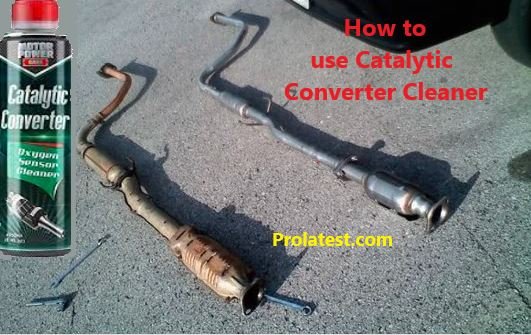With a new car, the catalytic converter is one of the most important parts of your engine. It’s responsible for converting harmful emissions into less damaging substances. To keep it in good condition, you need to clean it regularly with Catalytic Converter Cleaner. Therefore, this is a guide on how to use a catalytic converter cleaner.
Here is the procedure on how to use catalytic converter cleaner:
- Make sure that the exhaust pipe isn’t blocked and there are no leaks.
- Spray Catalytic Converter Cleaner onto all surfaces of the catalytic converter to remove dirt and grime.
- Let it stand for 30 minutes before removing excess cleaner using a cloth soaked in water.
- Rinse the Catalytic Converter with water and dry it gently.
- Repeat the process monthly or when needed, as determined by vehicle use and environmental factors.
A catalytic converter cleaner is a type of cleaning agent that’s designed specifically for your car’s catalytic converter. It works in much the same way as other cleaners, but they mostly work by stripping the catalytic converter of deposits and build-ups that can clog it up.
How to choose the right cleaner for your vehicle’s needs
This is the first step in the process of using a catalytic converter cleaner for your specific car. To do this, you can either look at the label of your catalytic converter or contact the manufacturer if you’re not sure what type it is. Once you have that information, then go shopping and buy a container of Catalytic converter cleaner. This is an important step to ensure you have the right catalytic converter that will not compromise the performance of your car’s engine.
Types of Catalytic Converter Cleaner
There are a few different types of Catalytic converter cleaners, and I will outline the steps you can take to use them in this blog post. The first type is just like any other spray or liquid car-cleaning product that we buy from the store. This solution should be sprayed on your catalytic converter using an extended straw (cleaning pipe for a car). The reason for using this pipe is to ensure that the catalytic cleaner is directed at the right place.
The second type of Catalytic converter cleaner is a special chemical that you use with a high-pressure hose. This method will take longer and it may be more difficult to get the right mix. However, if you don’t have any problems, this is the most effective way to clean your catalytic converters. The third option I want to mention is that you can clean your catalytic converter with gasoline.
With the first type of Catalytic converter cleaner, it’s important to start by spraying down all the visible surfaces on your car before applying any pressure to this product. The second method will only work if you have a high-pressure hose and special nozzle attachments for a garden hose (which you will need to buy separately).
The reason is that gasoline has a lower boiling point than water. In other words, the pressure of the gas alone can remove the dirt and grime from your catalytic converter without any scrubbing or scraping necessary. This process will take more time because it takes longer for gasoline to evaporate as well.
With the knowledge of the different types of catalytic converter cleaners around, let’s now see how to use them.
ALSO READ: The Best and Most Expensive Motorbikes
How to Use Catalytic Converter Cleaner
1. Make sure that the exhaust pipe isn’t blocked and there are no leaks
Cleaning a catalytic converter takes time and patience but it can be done by following these steps:
After you have read the instructions for your catalytic converter cleaner, gather and put on protective gear like goggles, gloves, apron, or knee pads. This will help to prevent unnecessary injury if something should go wrong during the procedure of cleaning the catalytic converters. Next, check the exhaust pipe and look for any signs of smoke or fumes. Turn off your engine. Make sure that there is no water in the gas tank.
The next thing is to spray down each section with water. This will help dissolve the dirt, oil, and grime while helping to spread the catalytic cleaner around as you scrub with a brush or stiff-bristles toothbrush.
2. Spray Catalytic Converter Cleaner onto all surfaces of the catalytic converter to remove dirt and grime
Make sure to get the converter’s insides.
Spray so that it does not drip because this could cause a fire hazard. Additionally, you need to do this carefully so that the catalytic cleaner is directed to the right surfaces.
3. Let it stand for 30 minutes before removing excess cleaner using a cloth soaked in water
Allow Catalytic Converter Cleaner to soak for at least 30 minutes before washing off with water. This will allow the cleaner time to do its job on the converter. It is advisable to wait for 30 minutes to avoid any instance of fire that might be caused by the catalytic converter cleaner.
Note: Do not use this product on a hot catalytic converter or when the vehicle is running because it can damage sensitive components and increase emissions. This will void any warranty coverage for that component of your car.
4. Rinse the Catalytic Converter with water and dry it gently
After washing the catalytic converter with water to remove the cleaner, you should rinse it with clean water. This ensures that your car’s catalytic converter does not retain any cleaner that might affect the operation of the engine once you start the car.
Do not overuse catalytic converter cleaner because this can cause damage to the engine of your car.
5. Repeat the process monthly or when needed, as determined by vehicle use and environmental factors
The two main factors that determine how frequently you will use a catalytic converter cleaner are vehicle use and environmental factors. Vehicle use is self-explanatory entailing that if the vehicle is used frequently or on daily basis, the cleaner should be used frequently. Otherwise, if you are not a frequent user of the vehicle, it is recommended to clean it once a month.
Environmental factors like rain, excessive sun, and cold impact the catalytic converter. The chances of the catalytic converter getting clogged are higher during the rainy season than in the sunny season. The mud on the road can have a high impact on the exhaust pipe which in turn, affects the operation of the catalytic converter.
Finally, Wash your hands with soap and pat dry with a towel before you take off the protective gear.
Expert Tip: Always wear protective gear like rubber gloves and a facemask when dealing with any type of chemical cleaner. This will help to prevent unnecessary injury if something should go wrong during the procedure of cleaning the catalytic converters.
RELATED: Most Popular Female Cars
How to Clean a Catalytic Converter Without Removing it
If you would like to clean your catalytic converter without removing it from the car, there are a few different methods that can be used. One such method is called pressure washing. This works by spraying water at high pressure on either side of the device until all dirt and grime are removed. If this doesn’t remove it all, you can use a degreaser to do the job.
Another method for cleaning your catalytic converter without removing is by using gasoline. Gasoline has a lower boiling point than water and will therefore be able to evaporate easier since it’s not in contact with any other material or object that could slow down the process (such as the catalytic converter).
However, the second method is not recommended as it leaves gasoline residue. This can be quite dangerous for you and other drivers of your vehicle. A third option would be to use a simple garden hose with an attachment that has sprayer nozzle features on it – such as a nozzle that releases wider streams of water at slower rates.
The most important thing to remember is that you should use the correct nozzle for your situation. If the items are delicate (such as a catalytic converter), then it’s best not to shoot them with high-pressured water – and instead opt for gentler, wider streams of more gentle water sprays or even just using a sponge/cloth with a water solution.
This will allow you to clean the item without damaging it and also help avoid any corrosion on metal items which can be particularly harmful. The next most important thing is that you use the correct cleaner for your situation – whether that’s a degreaser, proper glass cleaners, or even just diluted vinegar.
The benefits of using a cleaner on your car’s catalytic converter
- A high-quality Catalytic Converter Cleaner will contain a number of chemicals that can penetrate deeply into the pores and gaps in the metal surface to remove any built-up dirt.
- Catalytic Converters function by removing harmful unburnt hydrocarbons from exhaust pipes, which is why they are an important part of your car’s emissions control system.
Key Points from Blog Post
- Use a brush or stiff-bristles toothbrush to scrub the catalytic converter clean of dirt, oil, and grime.
- Always wear protective gear like rubber gloves and facemask when dealing with any type of chemical cleaner. This will help prevent injury as you work on this procedure.
- Catalytic converter clearners are highly flammable. Therefore, you should not use them close to fire places.
Please leave a comment about what you think after reading this guide on how to use catalytic converter cleaner.
SEO Writing
If you need help with your content process, you can either email us directly at info@prolatest.com or visit our contact page. We are an SEO company that offers professional writing services for companies looking to rank higher on Google. We are glad to serve you.







